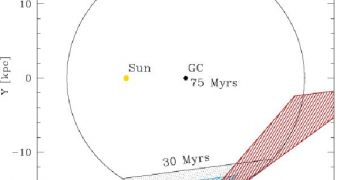In 1988, Los Alamos National Laboratory (LANL) astrophysicist Jack Hills used the theory of gravity to calculate the existence of a peculiar class of stars, whose members traveled faster than the galactic escape velocity. His calculations were inferred from a theoretical model in which a binary star system passed very close to a black hole. The simulation showed that, while one of the stars was trapped in orbit, the other was thrown away at high velocities thorough the Universe.
Astronomers had up to that point never observed such stars, but, after the theoretical model was ready, and they knew what they were looking for, they started spotting the runaway celestial bodies, traveling at incredibly large speeds. According to Hills' theory, these stars should move by at least 1,000 kilometers per second faster than the Milky Way's rest frame. Of all the stars classified as runaways, only HD 271791 allowed for most of its properties to be measured. It has about 11 times the mass of our own Sun, and it is also one of the first known stars to be on a path to escape the galaxy.
Because experts were able to infer its proper motion, they were capable of establishing its trajectory. And this is where Hills' model came under attack. Rather than originating at the core of the Milky Way, such as the theoretical prediction showed, measurements proved the star came from the galactic disk, some 3,000 light-years away from the core. However, Moscow State University expert Vasilii Gvaramadze admits, there are several possible explanations for the star's route and origin that do not require modifications to the theoretical work.
One of the explanations is that the star was set on its present course by a collision between the Milky Way and one of its dwarf, satellite galaxies. Tidal forces that resulted from the impact could have easily accelerated a star to impressive speeds. However, the star is very young, and other indicators of such a collision do not exist. Another proposal, which Gvaramadze dismisses, holds that HD 271791 was once part of a binary star system, and that its companion exploded into a supernova. The Russian expert says that such an explosion would have been insufficiently strong for such an effect.
The final theory is that the runaway star's trajectory may have been induced by violent interactions between three or four stars – as in two binary systems, or maybe a binary system and a massive star, more than 300 times the mass of the Sun. At this point, the only way to advance knowledge in this field is to assess HD 271791's composition, and to determine the proper motion of other similar formations, skyrocketing through the galaxy and the Universe, Technology Review reports.

 14 DAY TRIAL //
14 DAY TRIAL //